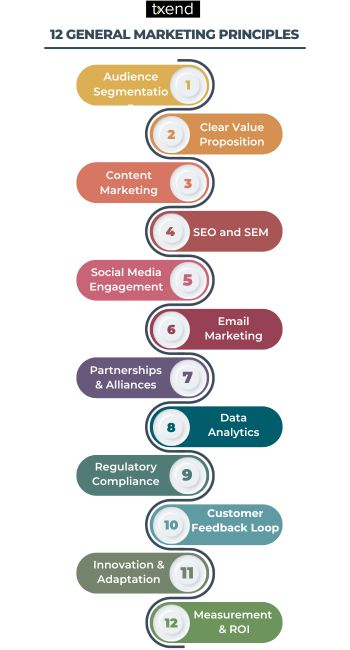In the fast-evolving landscape of financial technology, a well-crafted Fintech Marketing Strategy is the key to success in the USA market. As the fintech industry continues to grow, so does the need for strategic and effective marketing approaches.
Fintech Marketing Strategies
In this article, We will go into B2B financial technology marketing strategy, examine the subtleties of fintech advertising, and learn the tricks of the trade for effective fintech marketing.
In the digital age, mastering fintech digital marketing is essential for fintech companies looking to make their mark and capture the attention of both businesses and consumers alike.
Join us on this journey as we unlock the potential of the most effective fintech marketing strategies tailored specifically for the USA market.
Key Takeaways
- Financial Technology Marketing Strategy: A plan fintech companies use to promote their financial technology products and services effectively.
- Benefits of Financial Technology Marketing Strategy: Enhances awareness, customer engagement, and trust, driving growth and innovation in the fintech sector.
- Fintech Marketing Challenges: Regulatory compliance, competition, trust-building, cybersecurity, and adapting to changing consumer behavior are common challenges.
- Mitigation of Challenges: Address challenges through compliance, transparency, innovation, and customer-centric approaches to build trust and competitiveness.
- Community Marketing: Engaging users through online communities, fostering trust, user-generated content, and word-of-mouth marketing to promote fintech products.
12 General Marketing Principles
Developing a Financial Technology Marketing Strategy for the USA market is a multifaceted approach that requires a deep understanding of the fintech industry’s dynamics, the target audience, and the competitive landscape.

Let’s explore how to craft an effective fintech marketing strategy tailored to the USA:
Audience Segmentation:
Begin by identifying and segmenting your target audience. Understand the specific needs, pain points, and preferences of businesses and consumers in the USA. This segmentation will inform your messaging and channels.
Clear Value Proposition:
Craft a compelling value proposition that communicates what sets your fintech offering apart from competitors. Highlight how your solution addresses the unique challenges faced by your USA audience.
Content Marketing:
Produce informative and interesting material for your target audience. Produce blog posts, whitepapers, webinars, and videos that showcase your fintech expertise and provide value to users.
SEO and SEM:
Optimize your online presence with search engine optimization (SEO) techniques. Use relevant keywords and phrases to improve organic search rankings. Consider paid search advertising (SEM) to boost visibility.
Social Media Engagement:
Utilize social media channels to interact with your audience. Share informative content, engage in conversations, and use paid social advertising to reach a wider demographic.
Email Marketing:
Build and nurture your email list. Send personalized emails to your audience, including newsletters, product updates, and educational content.
Partnerships and Alliances:
Collaborate with other fintech companies or financial institutions in the USA to expand your reach. You can reach out to new customer bases with the aid of strategic alliances.
Data Analytics:
Utilize data analytics to track the performance of your marketing efforts. Monitor key metrics like website traffic, conversion rates, and customer acquisition costs. Adjust your strategy based on data-driven insights.
Regulatory Compliance:
Ensure that your marketing practices align with financial regulations in the USA, including data protection and privacy laws. Transparency in compliance can build trust with customers.
Customer Feedback Loop:
Establish a feedback mechanism to gather insights from customers. Their feedback can help you refine your product, messaging, and marketing strategy.
Innovation and Adaptation:
Keep abreast on market developments and new technologies. As the fintech landscape changes, be ready to modify your marketing plan.
Measurement and ROI:
Calculate your marketing activities’ return on investment (ROI). Assess the impact of your strategy on customer acquisition, revenue growth, and brand awareness.
A successful Financial Technology Marketing Strategy for the USA market requires a comprehensive and data-driven approach. By understanding your audience, crafting a compelling value proposition, and utilizing various marketing channels, you can position your fintech company for growth and success in the competitive US market.
Fintech Marketing Strategy Benefits
Having a well-defined Financial Technology Marketing Strategy in the USA offers numerous benefits, enhancing your market presence and driving business growth.
Here are some benefits, along with practical examples:
Targeted Audience Engagement:
A strategy helps you reach the right audience. For instance, PayPal’s targeted campaigns focus on attracting online shoppers, aligning with their audience’s interests.
Brand Awareness:
Effective marketing boosts brand recognition. Square’s clever branding and marketing efforts have made its point-of-sale solutions synonymous with small businesses.
Customer Acquisition:
Marketing strategies like Robinhood’s referral programs incentivize users to invite others, driving customer growth through word-of-mouth.
Competitive Edge:
It’s critical to stand out in a crowded market. Stripe’s unique selling proposition, focusing on developer-friendly payment processing, has helped it gain a competitive edge.
Thought Leadership:
Educational content, like Visa’s Insights hub, positions your company as an industry authority, fostering trust and credibility.
Lead Generation:
Engage in lead generation through content marketing. HubSpot, a marketing platform, uses this approach effectively to attract potential customers.
Customer Retention:
Fintechs like Intuit invest in customer retention through personalized services and loyalty programs, reducing churn rates.
Measurable ROI:
Effective strategies offer measurable returns. Adyen, a global payments company, tracks its campaign performance meticulously to optimize spending.
Adaptability:
A strategy allows you to adapt to market changes. During the pandemic, digital wallet apps like Apple Pay swiftly adapted to contactless payment demands.
Regulatory Compliance:
Aligning marketing practices with financial regulations, as demonstrated by Plaid, fosters consumer trust and ensures legal compliance.
A well-designed Fintech Marketing Strategy in the USA offers a success road map, allowing fintech businesses to efficiently target their audience, establish their brand, spur growth, and keep a competitive advantage in a fast-moving market. Practical examples from successful fintech companies demonstrate the tangible benefits of having a strategic approach to marketing.
15 Best Fintech Marketing Strategies

Content Marketing:
Produce informative blogs, articles, and videos to educate and engage your target audience about your fintech products and services.
SEO Optimization:
Utilize SEO strategies to increase your website’s visibility in search results and generate organic traffic.
Social Media Marketing:
Leverage platforms like LinkedIn, Twitter, and Facebook to build a strong social presence and connect with your audience.
Email Marketing:
Send personalized emails with relevant content and offers to nurture leads and retain existing customers.
Paid Advertising:
To reach a larger audience, spend money on sponsored advertising campaigns on websites like Google Ads and social media.
Influencer Marketing:
Collaborate with industry influencers to promote your fintech solutions to their followers.
Video Marketing:
Create engaging video content to explain your services, share success stories, and connect with users visually.
Referral Programs:
Implement referral programs that incentivize existing customers to refer new clients, driving word-of-mouth marketing.
Segmented Marketing:
Tailor your marketing messages to different customer segments based on their needs and preferences.
Community Building:
Foster online communities or forums where users can discuss fintech trends and your products.
Partnerships:
Forge partnerships with complementary fintech companies or financial institutions to expand your reach and services.
Webinars and Workshops:
Host webinars and workshops to showcase your expertise and interact directly with potential clients.
Interactive Content:
Develop interactive tools, calculators, or quizzes that engage users and demonstrate the value of your fintech solutions.
Mobile Marketing:
Optimize your marketing for mobile users, ensuring your website and content are mobile-friendly.
Data Analytics:
Utilize data analytics to monitor the success of your marketing initiatives so that you may make data-driven adjustments.
These strategies, when executed effectively, can help fintech companies in the USA market build brand awareness, acquire and retain customers, and drive growth in this highly competitive industry.
10 Fintech Marketing Challenges
- Regulatory Compliance
- Customer Trust
- Intense Competition
- Adoption Barriers
- Cybersecurity Concerns
- Talent Acquisition
- Changing Consumer Behavior
- Budget Constraints
- Data Analytics Complexity
- Brand Building
Regulatory Compliance:
Staying abreast of complex and evolving financial regulations requires continuous effort to ensure marketing practices align with compliance.
Customer Trust:
Establishing trust with consumers, particularly when handling sensitive financial data, is crucial but can be challenging in an era of data privacy concerns.
Intense Competition:
The USA fintech market is saturated, making it difficult to stand out. New entrants must find unique selling points.
Adoption Barriers:
Convincing consumers and businesses to adopt new fintech solutions can be an uphill battle, especially when they are accustomed to traditional methods.
Cybersecurity Concerns:
Heightened cybersecurity risks and data breaches necessitate robust security measures, which can be costly to implement and maintain.
Talent Acquisition:
Recruiting and retaining marketing professionals with fintech expertise can be competitive and costly.
Changing Consumer Behavior:
Adapting to shifting consumer behavior, such as the preference for mobile banking, requires nimbleness and innovation.
Budget Constraints:
Limited marketing budgets, particularly for startups, may restrict the scope and reach of marketing campaigns.
Data Analytics Complexity:
Effectively leveraging data analytics for targeted marketing requires expertise and investment in analytics tools.
Brand Building:
Establishing a strong and reputable fintech brand takes time and consistent effort, often challenging for newcomers.
Addressing these challenges involves a combination of regulatory compliance, robust security measures, innovative marketing strategies, and a deep understanding of the evolving fintech landscape in the USA. Success lies in a well-rounded approach that encompasses both marketing expertise and fintech industry knowledge.
Solution of the FinTech Marketing Challenges

Mitigating the challenges in Fintech Marketing in the USA involves strategic approaches:
Regulatory Compliance:
Stay updated on financial regulations, ensuring marketing practices align. Consult legal experts for guidance.
Customer Trust:
Emphasize data security, privacy policies, and transparent practices to build and maintain trust with consumers.
Intense Competition:
Differentiate through innovation, unique features, and a compelling value proposition in your marketing messages.
Adoption Barriers:
Educate potential users about the benefits of fintech solutions, addressing concerns and highlighting convenience.
Cybersecurity Concerns:
Invest in robust cybersecurity measures and communicate them to reassure customers about data protection.
Talent Acquisition:
Attract top marketing talent with competitive compensation, professional development opportunities, and a dynamic work environment.
Changing Consumer Behavior:
Continuously adapt to evolving consumer preferences and technology trends in your marketing strategies.
Budget Constraints:
Allocate marketing budgets wisely, prioritizing channels and campaigns with the highest potential ROI.
Data Analytics Complexity:
Invest in analytics tools and expertise to extract valuable insights for targeted marketing.
Brand Building:
Build a strong and reputable brand over time through consistent messaging and positive user experiences.
Mitigating these challenges requires a holistic approach, combining legal compliance, cybersecurity, strategic marketing, and a deep understanding of the fintech landscape. Effective mitigation strategies can position fintech companies for long-term success in the USA market.
What is FinTech Community Marketing?
The use of online or offline communities by fintech companies to interact with their target market is known as community marketing. This involves building and nurturing communities of users, customers, or enthusiasts who share common interests related to the fintech’s offerings.
In the context of fintech, community marketing can take various forms:
Online Forums and Social Media Groups:
Creating and moderating forums, groups, or communities on platforms like Reddit, LinkedIn, or Facebook where users can discuss fintech topics, share experiences, and seek advice.
User-Generated Content:
Encouraging users to create content such as reviews, testimonials, or educational material that highlights the benefits of your fintech products or services.
Events and Webinars:
Hosting virtual or in-person events, webinars, or conferences where users can connect, learn, and engage with fintech experts and industry leaders.
Feedback and Beta Testing:
Seeking feedback from the community on product features, updates, or improvements, and involving them in beta testing to enhance user experience.
Advocacy Programs:
Identifying and empowering brand advocates within the community who can promote your fintech solutions to a wider audience.
Community marketing fosters a sense of belonging and trust among users, facilitates word-of-mouth marketing, and provides valuable insights into customer needs and preferences.
It can be a powerful strategy to enhance brand loyalty and drive user acquisition and retention in the competitive fintech landscape.
FinTech Marketing Success Stories in the USA
Here are a few noteworthy FinTech Marketing Success Stories in the USA:
Square:
Square’s marketing success lies in its simplicity and accessibility. The company targeted small businesses with straightforward messaging, emphasizing ease of use and transparency in fees. Their iconic white card reader became a recognizable symbol of their brand.
Robinhood:
Robinhood disrupted the brokerage industry by offering commission-free trading. Their marketing strategy focused on making investing accessible to everyone. The “Free Stock” referral program created a viral effect, attracting a large user base.
PayPal:
PayPal’s marketing success is built on trust and reliability. They leveraged partnerships and integrations with major e-commerce platforms and emphasized secure online payments, establishing themselves as a leader in online transactions.
Chime:
Chime, a neobank, used a referral program to grow its customer base. Offering a cash bonus for referrals and a “Get Paid Early” feature for direct deposits, they attracted millennials and gig workers looking for convenient banking solutions.
Adyen:
Adyen, a payment platform, focused on transparency and global expansion. Their marketing emphasized providing a seamless payment experience for customers like Uber and Spotify, gaining trust and credibility in the industry.
These success stories highlight the importance of clear messaging, user-centric marketing, innovative features, and building trust in the fintech industry.
Each company addressed specific pain points or needs in the market and effectively communicated their value proposition to capture a significant share of the market.
How can Txend help design an effective Financial Technology marketing strategy?
To design an effective Fintech Marketing Strategy for the USA market, you can consider leveraging the capabilities of Txend.
Here’s how Txend can assist:
- Market Research: Txend can conduct in-depth market research to understand the specific needs and preferences of the USA audience. This research forms the foundation of a tailored marketing strategy.
- Competitive Analysis: Txend can analyze the competitive landscape to identify gaps and opportunities, allowing your fintech company to differentiate itself effectively.
- Target Audience Segmentation: Txend can assist in segmenting your target audience based on demographics, behaviors, and preferences, enabling precise targeting and personalized messaging.
- Content Creation: Txend can develop high-quality content, including blog posts, videos, infographics, and whitepapers, to engage and educate the audience about your fintech solutions.
- SEO and SEM: Txend can optimize your online presence through SEO techniques and manage paid advertising campaigns (SEM) to improve visibility and attract relevant traffic.
- Social Media Management: Txend can handle your social media marketing, creating and managing profiles on platforms like LinkedIn, Twitter, and Facebook to engage with the audience.
- Email Marketing: Txend can develop and execute email marketing campaigns, nurturing leads and retaining customers through personalized email content.
- Data Analytics: Txend can provide data analytics services, tracking the performance of marketing efforts, identifying trends, and making data-driven recommendations for optimization.
- Compliance Guidance: Txend can ensure that all marketing practices align with financial regulations in the USA, including data protection and privacy laws.
- Partnerships and Alliances: Txend can explore partnership opportunities with complementary fintech companies or financial institutions to expand your reach and services.
- Community Building: Txend can assist in building and nurturing online communities or forums where users can discuss fintech trends and your products.
- Brand Building: Txend can work on establishing a strong and reputable fintech brand through consistent messaging and positive user experiences.
By partnering with Txend, your fintech company can access specialized expertise and resources to develop and execute a tailored and effective marketing strategy for the USA market.
Txend’s industry knowledge and marketing experience can help you navigate the unique challenges and opportunities in the fintech landscape.
Frequently Asked Questions
Fintech marketing strategy is a plan that fintech companies in the USA use to promote their financial technology products and services. It’s crucial for individuals as it helps them discover innovative and convenient financial solutions tailored to their needs.
Fintech advertising informs consumers about new fintech offerings, making them aware of better financial tools and services, ultimately leading to more informed financial decisions and improved financial well-being.
Yes, while B2B fintech marketing primarily targets businesses, it indirectly benefits individual consumers by driving competition and innovation, resulting in more consumer-friendly fintech products and services.
Fintech digital marketing enhances accessibility by promoting online and mobile financial services. It makes it easier for individuals in the USA to access their accounts, make transactions, and manage their finances conveniently from their devices.
Conclusion
In conclusion, crafting a successful Fintech Marketing Strategy tailored specifically for the USA market requires a multifaceted approach that encompasses fintech advertising, B2B fintech marketing strategy, marketing for fintech, and fintech digital marketing.
Fintech companies may successfully reach their target audience and spur growth in the cutthroat US market by comprehending the distinctive features of this quickly changing terrain and embracing creative marketing strategies.
The most effective strategy combines data-driven insights, customer-centric messaging, and regulatory compliance to establish a strong and reputable fintech brand, ultimately leading to success in the dynamic world of financial technology.



